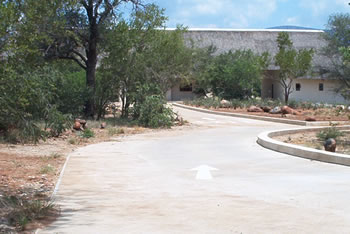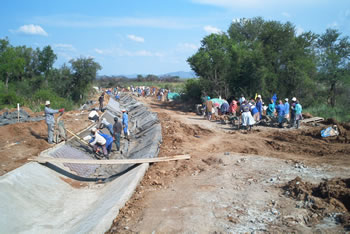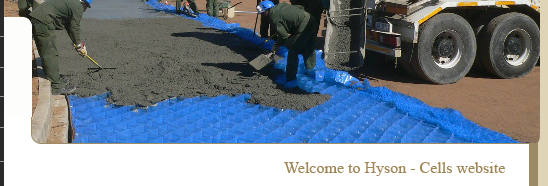ROADS, STORM WATER AND CANALS
Rural roads and difficult terrain
The following is extracted from a paper “Innovative and cost effective solutions for roads in rural areas and difficult terrain” by Prof. AT Visser.
The full paper is obtainable from our autoresponder by sending an email with the keyword “RD03” as the subject to mshot@hysoncells.co.za
“In many parts of the world high level engineering solutions are inappropriate for rural areas where expertise and skills, including equipment, are unavailable. Often these areas suffer from difficult terrain that also makes accessibility a problem. The structural design and construction processes therefore needs to be uncomplicated.”
Township roads

“Township roads in the sandy areas of the coastal regions were built with the in-situ materials. The sand and cement was mixed in wheelbarrows by labor from the local community. A special process was developed whereby the cement and water was first mixed, and then the sand was added. Cube strengths obtained with this process were 20% higher than if the sand and cement was mixed dry and the water then added. An added benefit was that no specialized construction equipment was required. The cross-section profile was such that the water was carried in the middle of the road. The big advantage of this was that it also gave the community another 5 m of side space for the children to play football without being in the way of the vehicles.
Mountain roads
A number of roads and drains down the mountains in rural areas have been built. The oldest of these has been in service for eight years, and has not required any maintenance. Previously these roads needed extensive routine maintenance, and despite this the road was in poor condition and placed major strain on the vehicles in the rainy season. It was also found that under these conditions, including the drain within the road allows for less material to be excavated and used for paving, and cost savings in construction of the road up to 50% was achieved.
The road to microwave towers is textured to ensure access even in the worst storm. This can be achieved even with local material from the nearest river being used in the concrete or grout mix. In some environmentally sensitive areas the natural aggregate is left proud of the surface, or a pigment is added to the concrete so that it can blend with the local environment and not provide a scar visible from far.
Roads to tailings dams
A special application of the combined drain/road geocell system is on the slimes dumps at gold and platinum mines. The mines use the system on the outside of tailings dams to remove the water that forms on the top and it gives simultaneous access to the top of the dam at all times to check on the workings of the pumps and drainage systems. These mine dump overflows and drains on mountains have taken reported flow velocities of up to 18 meters per second. To combat potential problems in terms of erosion and scour, large settlement ponds were constructed at the base of the drain. These ponds serve a dual purpose as they are also used as water storage areas for animals, which is a major benefit in a water-poor country.
Roads in game reserve

Hyson Cells was used for a network of roads in an up-market game reserve at Hoedspruit, giving a quality product in a remote region at reasonable price.
Canals and stormwater
25 km canal constructed with farm labour

The 25km Hereford canal at Groblersdal was constructed in just 6 months. The main contractor did the surveying and excavations but the Hyson lining was constructed using teams of farm labour 30 strong. Sand was taken from the local river.
The full paper is obtainable from our autoresponder by sending an email with the keyword “LB02” as the subject to mshot@hysoncells.co.za
Hyson canal out-lasted conventional concrete panel canal
During 1995 a section of the Transvaal canal, main feeder of the left bank irrigation as well as domestic supply to Pongola Town Council was used to test Hyson Cells as alternative to conventional concrete canal lining panels. At the same time, permission was granted to line a two-kilometre drainage canal at the airfield to solve serious overland flooding problems during rainstorms of the past.
After ten years Mr Bossie Bosman (now retired) of Department of Water Affairs reported that with the Hyson Cells there was
-
No movement of the canal
- No cracking along the Hyson Cells walls
- The canal surface showed no weathering and appeared smooth as the day of construction”
- However, the conventional lining did not perform as well. Mr Bosman continues:
“As no agricultural activity was foreseen above the up stream embankment of the Transvaal canal, no under drainage was designed or constructed for this purpose. Over land drainage above upstream embankment was provided. The removal of the natural vegetation, irrigation of sugar cane complemented by over land run off, caused the ground water level to rise, with the result that sixteen 5m panels of the newly built Transvaal canal over a distance of 155mm broke as well as causing some panels to move. The heavy clay soils of the area in question provided little if any lateral drainage so as to drain excess ground water quick enough from behind the canal to lower reaches where there is the possibility for disposal thereof to prevent damages of the above kind.”
The Hyson canal is now 15 years old (as at 2010) and is understood to still be “as constructed”
|





